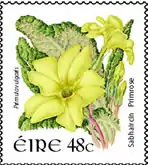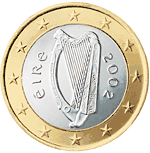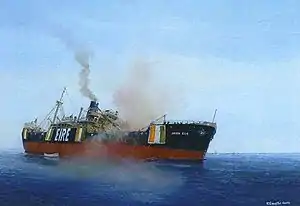Éire
Éire (Irish: [ˈeːɾʲə] (![]() listen)) is Irish for "Ireland", the name of an island and a sovereign state.
listen)) is Irish for "Ireland", the name of an island and a sovereign state.

Etymology
The modern Irish Éire evolved from the Old Irish word Ériu, which was the name of a Gaelic goddess. Ériu is generally believed to have been the matron goddess of Ireland, a goddess of sovereignty, or simply a goddess of the land. The origin of Ériu has been traced to the Proto-Celtic reconstruction *Φīwerjon- (nominative singular Φīwerjū < Pre-Proto-Celtic -jō).[1] This suggests a descent from the Proto-Indo-European reconstruction *piHwerjon-, likely related to the adjectival stem *piHwer- (cf. Sanskrit pīvan, pīvarī and pīvara). This would suggest a meaning of "abundant land".
This Proto-Celtic form became *Īweriū in Proto-Goidelic.[2] It is highly likely that explorers borrowed and modified this term. During his exploration of northwest Europe (circa 320 BC), Pytheas of Massilia called the island Ierne (written Ἰέρνη). In his book Geographia (circa 150 AD), Claudius Ptolemaeus called the island Iouernia (written Ἰουερνία; ou represented /w/). Based on these historical accounts, the Roman Empire called the island Hibernia.
The evolution of the word would follow as such:
- Proto-Celtic *Φīwerjon- (nominative singular *Φīwerjū)
- Proto-Goidelic *Īweriū
- Old Irish Ériu
- Modern Irish Éire
- Old Irish Ériu
- Proto-Goidelic *Īweriū
A 19th century proposal, which does not follow modern standards of etymology, derives the name from Scottish Gaelic:
- ì (island) + thiar (west) + fónn (land), which together give ì-iar-fhónn, or "westland isle"[3]
The etymology fails in that tiar (the historical form) has no *téir forms which would allow the development of the *é of Éire; moreover, Old Irish (= Old Gaelic) í "island" was a late loan word from Old Norse ey "island", and so did not exist in prehistoric Ireland.
Difference between Éire and Erin
While Éire is simply the name for the island of Ireland in the Irish language, and sometimes used in English, Erin is a common poetic name for Ireland, as in Erin go bragh. The distinction between the two is one of the difference between cases of nouns in Irish. Éire is the nominative case, the case that is used for nouns that are the subject of a sentence, i.e., the noun that is doing something as well as the direct object of a sentence. Erin derives from Éirinn, the Irish dative case of Éire, which has replaced the nominative case in Déise Irish and some non-standard sub-dialects elsewhere, in Scottish Gaelic (where the usual word for Ireland is Èirinn) and Manx (like Irish and Scottish Gaelic, a Goidelic Celtic language), where the word is spelled "Nerin," with the initial n- probably representing a fossilisation of the preposition in/an "in" (cf. Irish in Éirinn, Scottish an Èirinn/ann an Èirinn "in Ireland"). The genitive case, Éireann (e.g. stair na hÉireann "the history of Ireland, Ireland's history"), is found in the Gaelic forms of the titles of companies and institutions in Ireland e.g. Iarnród Éireann (Irish Rail), Dáil Éireann (Irish Parliament), Poblacht na hÉireann (The Republic of Ireland) or Tuaisceart Éireann (Northern Ireland),
As a state name


Article 4 of the Irish constitution adopted in 1937 by the government under Éamon de Valera states that Éire is the name of the state, or in the English language, Ireland.[4] The Constitution's English-language preamble also describes the population as "We, the people of Éire". Despite the fact that Article 8 designated Irish as the "national" and "first official" language, Éire has to some extent passed out of everyday conversation and literature, and the state is referred to as Ireland or its equivalent in all other languages. The name "Éire" has been used on Irish postage stamps since 1922;[5] on all Irish coinage (including Irish euro coins); and together with "Ireland" on passports and other official state documents issued since 1937. "Éire" is used on the Seal of the President of Ireland.
Initially after 1937 the United Kingdom insisted on using only the name "Eire" and refused to accept the name "Ireland". It adopted the Eire (Confirmation of Agreements) Act 1938 putting in law that position. At the 1948 Summer Olympics in London the organisers insisted that the Irish team march under the banner "Eire" notwithstanding that every other team was marching according to what their name was in English.[6] The UK Government generally avoided all reference to "Ireland" in connection with the state and used what Senator Thomas O'Connell described as "sneering titles such as Eirish".[7] However, the term "Eirish" was also used by some writers in the US, who referred to "the Eirish people".[8] Using the genitive form Éireann as an adjective, the UK media would refer to "Eireann Ministers"[9] and the "Eireann Army".[10] The Ireland Act 1949 changed this to "Republic of Ireland". It was not until after the 1998 Good Friday Agreement that the UK government accepted the preferred name of simply "Ireland", at the same time as Ireland dropped its territorial claim over Northern Ireland.
Before the 1937 Constitution, "Saorstát Éireann" (the Irish name of the Irish Free State) was generally used.[11]
During the Emergency (as World War II was known), Irish ships had "EIRE" (and the Irish tricolour) painted large on their sides and deck, to identify them as neutrals.
In the 1947 Sinn Féin Funds case, a co-defendant was cited as "the Attorney General of Eire" in the High and Supreme Court cases, and there were similar cases where "Eire" was used in the late 1940s as a descriptor of the state in English.[12]

In 1922–1938 the international plate on Irish cars was "SE". From 1938 to 1962 it was marked "EIR", short for Éire. In 1961 statutory instrument no. 269 allowed "IRL",[13] and by 1962 "IRL" had been adopted. Irish politician Bernard Commons TD suggested to the Dáil in 1950 that the government examine "the tourist identification plate bearing the letters EIR ... with a view to the adoption of identification letters more readily associated with this country by foreigners".[14] "EIR" is also shown in other legislation such as the car insurance statutory instrument no. 383 of 1952 and no. 82 of 1958.[15][16]
Under the 1947 Convention Irish-registered aircraft have carried a registration mark starting "EI" for Éire.
From January 2007, the Irish government nameplates at meetings of the European Union have borne both Éire and Ireland, following the adoption of Irish as a working language of the European Union.
Spelling Eire rather than Éire
When Irish-language texts were printed in Gaelic type, diacritics were retained on upper-case letters as for lower-case letters. From the later 1940s, in conjunction with other reforms, printing switched to the same "Roman type" used for most other Latin alphabet languages. There was some uncertainty about whether the síneadh fada (acute accent) should be written on upper-case letters. While it was preserved in all-Irish texts, it was often omitted when short fragments of Irish appeared alone or in English texts. Noel Davern asked in the Dáil in 1974 why Irish stamps had EIRE rather than ÉIRE. The reply from the Minister for Posts and Telegraphs was:[17]
The accent has been omitted on most Irish stamps issued over the past ten years in the interests of artistic balance and in accordance with a common practice in the printing of Irish in Roman script for display purposes. This is a prevailing typographical convention and is common to several European languages, including French.
Davern considered the spelling Eire to be worse than a misspelling, because eire is a separate word, meaning "a burden, load or encumbrance".[17][18] The minister stated, "The word on the stamp ... does not mean 'eire' and it is not understood to mean 'eire' by anybody except Davern."[17] Stamps later reverted to a Gaelic type with the accent preserved.
In 1938 the British government provided in the Eire (Confirmation of Agreements) Act 1938 that British legislation would henceforth refer to the Irish Free State as "Eire" (but not as "Ireland"). This was altered by the Ireland Act 1949, where the English-law name of the state was changed to "Republic of Ireland".[19] The 1938 Act was repealed in 1981, and in 1996 a British journalist described Eire as "now an oddity rarely used, an out-of-date reference".[20]
Founded in 1937, the Eire Society of Boston is an influential Irish-American group.[21]
Other uses
Éire has also been incorporated into the names of Irish commercial and social entities, such as Eir (formerly Eircom and Telecom Éireann) and its former mobile phone network, Eircell.[22] Ireland's postal code system is known as Eircode. In 2006 the Irish electricity network was devolved to EirGrid. The company "BetEire Flow" (eFlow), named as a pun on "better", is a French consortium running the electronic tolling system at the West-Link bridge west of Dublin.[23] According to the Dublin Companies Registration Office in 2008, over 500 company names incorporate the word Éire in some form.[24]
Footnotes
- "Celtic Lexicon - University of Wales". www.wales.ac.uk.
- Mallory, J.P. and D.Q. Adams, ed. Encyclopedia of Indo-European Culture. London: Fitzroy Dearborn Pub., 1997, p. 194
- Forbes, John (1848), The Principles of Gaelic Grammar (2nd ed.), Edinburgh: Oliver and Boyd, p. 160,
The Celtic words ì, inns, an island, will forma key to the etymology of the names of many insular and peninsular places in the world; as, Ile, Islay. Jura or Iura, Jura. Uist, Uist, Inchkeith, isle of Keith. Eireinn, or Eirionn, ì-iar-fhónn, wetland isle; Ireland.
- "Constitution of Ireland Archived 30 April 2008 at the Wayback Machine". Office of the Houses of the Oireachtas. Retrieved on 14 March 2007
- Hamilton-Bowen, Roy (2009). Roy Hamilton-Bowen (ed.). Hibernian Handbook and Catalogue of the Postage Stamps of Ireland. Rodgau, Germany: Rodgau Philatelic Service GmbH.
- O'Leary, Jennifer (9 March 2012). "Celebrating champions". Archived from the original on 6 May 2015 – via www.bbc.com.
- The Republic of Ireland Bill, 1948, Seanad Éireann debate, Vol. 36 No. 2, Friday, 10 December 1948
- The Literary Digest, Volume 124, Funk and Wagnalls, 1938, pages 8-9
- Chronology of International Events and Documents, Volume 4, Royal Institute of International Affairs, 1947, page 690
- The Motor, Volume 78, page 213
- (eISB), electronic Irish Statute Book. "electronic Irish Statute Book (eISB)". www.irishstatutebook.ie. Archived from the original on 19 May 2015.
- Buckley and others v. the Attorney General of Eire and Charles Stewart Power, 1 Irish Reports [1950], 57.
- SI 269 of 1961:"...the letters EIR are used to indicate the name of the State but the letters IRL may be substituted therefor."
- "Dáil Éireann – Volume 119 - 22 March, 1950 – Ceisteanna—Questions. Oral Answers. – Motor Identification Letters". Historical-debates.oireachtas.ie. 22 March 1950. Archived from the original on 7 June 2011. Retrieved 26 March 2010.
- "SI 82 of 1958 text". Irishstatutebook.ie. 31 December 1959. Archived from the original on 20 February 2009. Retrieved 26 March 2010.
- "SI 383 of 1952". Irishstatutebook.ie. Archived from the original on 20 February 2009. Retrieved 26 March 2010.
- "Ceisteanna —Questions. Oral Answers. - Irish Postage Stamps". Dáil debates. 271 (8): 38 cc.1140–1. 28 March 1974. Archived from the original on 11 May 2018.
- "Foclóir Gaeilge-Béarla (Ó Dónaill, 1977)".
- Ireland Act 1949, section 1(3)
- Wilson, John (1996). Understanding journalism: a guide to issues. Routledge. p. 269. ISBN 9780415115995.
- The Eire Society of Boston's history page on-line Archived 26 July 2011 at the Wayback Machine (seen on 25 August 2011)
- "eir homepage". Eir.ie. 29 November 2006. Archived from the original on 21 September 2015. Retrieved 26 March 2010.
- "National Roads Authority statement 2007". Nra.ie. Archived from the original on 23 August 2010. Retrieved 26 March 2010.
- "CRO search page". Cro.ie. Archived from the original on 29 December 2010. Retrieved 26 March 2010.
Bibliography
| Look up Éire in Wiktionary, the free dictionary. |
- Noel Browne, Against the Tide
- Constitution of Ireland (1937)
- Stephen Collins, The Cosgrave Legacy
- Tim Pat Coogan, De Valera (Hutchinson, 1993)
- Brian Farrell, De Valera's Constitution and Ours
- F.S.L. Lyons, Ireland since the Famine
- David Gwynn Morgan, Constitutional Law of Ireland
- Tim Murphy and Patrick Twomey (eds.) Ireland's Evolving Constitution: 1937–1997 Collected Essays (Hart, 1998) ISBN 1-901362-17-5
- Alan J. Ward, The Irish Constitutional Tradition: Responsible Government and Modern Ireland 1782–1992 (Irish Academic Press, 1994) ISBN 0-7165-2528-3